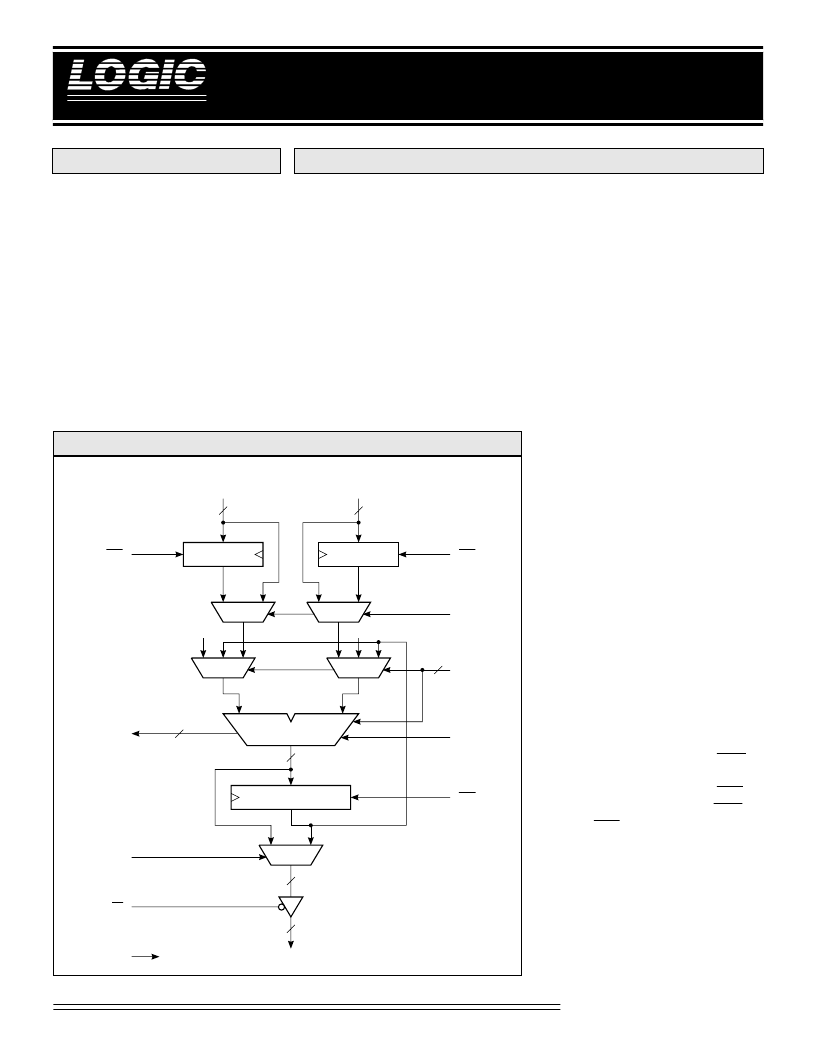- 您現(xiàn)在的位置:買賣IC網(wǎng) > PDF目錄377595 > L4C383 (Logic Devices Incorporated) 16-bit Cascadable ALU (Extended Set) PDF資料下載
參數(shù)資料
| 型號: | L4C383 |
| 廠商: | Logic Devices Incorporated |
| 英文描述: | 16-bit Cascadable ALU (Extended Set) |
| 中文描述: | 16位ALU的級聯(lián)(擴(kuò)展集) |
| 文件頁數(shù): | 1/11頁 |
| 文件大小: | 83K |
| 代理商: | L4C383 |

DEVICES INCORPORATED
L4C383
16-bit Cascadable ALU (Extended Set)
16-bit Cascadable ALU (Extended Set)
Arithmetic Logic Units
08/16/2000–LDS.383-E
1
K
High-Speed (15ns), Low Power
16-bit Cascadable ALU
K
Extended Function Set
(32 Advanced ALU Functions)
K
All Registers Have a Bypass Path
for Complete Flexibility
K
Replaces IDT7383
K
68-pin PLCC, J-Lead
FEATURES
DESCRIPTION
DEVICES INCORPORATED
L4C383 B
LOCK
D
IAGRAM
The
L4C383
is a flexible, high speed,
cascadable 16-bit Arithmetic and Logic
Unit. The L4C383 is capable of
performing up to 32 different
arithmetic or logic functions.
The L4C383 can be cascaded to perform
32-bit or greater operations. See
“Cascading the L4C383” on the next
page.
ARCHITECTURE
The L4C383 operates on two 16-bit
operands (A and B) and produces a 16-
bit result (F). Five select lines control
the ALU and provide 19 arithmetic and
13 logical functions. Registers are
provided on both the ALU inputs and
the output, but these may be bypassed
under user control. An internal feed-
back path allows the registered ALU
output to be routed to one or both of
the ALU inputs, accommodating chain
operations and accumulation.
ALU OPERATIONS
The S
4
–S
0
lines specify the operation to
be performed. The ALU functions and
their select codes are shown in Table 1.
ALU STATUS
The ALU provides Overflow and Zero
status bits. A Carry output is also
provided for cascading multiple
devices, however it is only defined for
the 19 arithmetic functions. The ALU
sets the Zero output when all 16 output
bits are zero. The N, C
16
and OVF flags
for the arithmetic operations are
defined in Table 2.
OPERAND REGISTERS
The L4C383 has two 16-bit wide input
registers for operands A and B. These
registers are rising edge triggered by a
common clock. The A register is
enabled for input by setting the ENA
control LOW, and the B register is
enabled for input by setting the ENB
control LOW. When either the ENA
control or ENB control is HIGH, the
data in the corresponding input register
will not change.
This architecture allows the L4C383 to
accept arguments from a single 16-bit
data bus. For those applications that do
not require registered inputs, both the
A and B operand registers can be
bypassed with the FTAB control line.
A REGISTER
B REGISTER
ALU
RESULT REGISTER
A
15
-A
0
B
15
-B
0
F
15
-F
0
FFFF
H
FFFF
H
ENB
FTAB
S
4-0
N, C
16
OVF, Z
ENF
FTF
OE
CLK
ENA
16
16
5
4
16
16
16
TO ALL REGISTERS
C
0
相關(guān)PDF資料 |
PDF描述 |
|---|---|
| L514-G | MR11 and MR16 Halogen Lamps with Gold Coated Reflectors |
| L515-G | MR11 and MR16 Halogen Lamps with Gold Coated Reflectors |
| L517A-G | MR11 and MR16 Halogen Lamps with Gold Coated Reflectors |
| L519-G | MR11 and MR16 Halogen Lamps with Gold Coated Reflectors |
| L521-G | MR11 and MR16 Halogen Lamps with Gold Coated Reflectors |
相關(guān)代理商/技術(shù)參數(shù) |
參數(shù)描述 |
|---|---|
| L4C383GC15 | 制造商:未知廠家 制造商全稱:未知廠家 功能描述:Fixed Point ALU |
| L4C383GC20 | 制造商:未知廠家 制造商全稱:未知廠家 功能描述:Fixed Point ALU |
| L4C383GC26 | 制造商:未知廠家 制造商全稱:未知廠家 功能描述:Fixed Point ALU |
| L4C383GC40 | 制造商:未知廠家 制造商全稱:未知廠家 功能描述:Fixed Point ALU |
| L4C383GC55 | 制造商:未知廠家 制造商全稱:未知廠家 功能描述:Fixed Point ALU |
發(fā)布緊急采購,3分鐘左右您將得到回復(fù)。